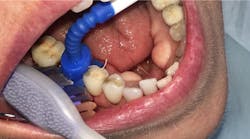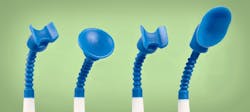Biofilm management is critical to the outcomes of implant therapy, but patient compliance with home care can be less than ideal due to the pain involved with brushing around the surgical site. In this article, Katherine A. Haltom, DMD, and Ivy H. Zellmer, RDH, BSDH, introduce Mouth-Mate, a new device that protects the surgical site to permit safe brushing without pain.
One of the greatest concerns of implant therapy for both patients and clinicians is the potential that the implant might fail. In 2015 the prevalence of peri-implantitis was reported to be as low as 1% and as high as 47%. (1) According to Tarnow, “Under the most conservative estimates, nearly 10% of all implants placed today will have some form of peri-implantitis in about 10 years.” (2) The range of reported peri-implantitis prevalence is controversial; however, it is commonly agreed that key features of peri-implant diseases are plaque biofilm and poor patient hygiene. (3) In this article, we will introduce a modern, nontraditional strategy to help ensure improved postsurgical patient comfort and hygiene at home, which are key to improved long-term implant success.
Plaque biofilm has been named the enemy. We are familiar with the association between plaque and the development of peri-implant diseases. (1,3,4) One key strategy to ensure continued implant success is to emphasize a proper oral hygiene program at home. (2–5) Good home care and plaque management are critical and should be stressed from the very beginning, long before the final implant-borne restoration.
The “self-care” mantra should be stressed by the dental team during the presurgical workup and reinforced after surgery to reduce site contamination and inflammation, and to improve implant and graft success. (4) This early approach will bolster the importance of establishing thorough and consistent oral hygiene behavior at home, and it will help to form a clinician–patient partnership so the most successful patient outcomes can be achieved. Patients will understand that implant care starts from the very beginning with the surgery, not after the final restoration.
Whether it’s a one- or two-stage implant surgery, plaque biofilm around the surgical site is a constant threat. Biofilm can lead to mucosal inflammation, delayed healing, and an increased risk of infection and patient pain. If a patient doesn't adhere to a biofilm management protocol, a preeminent concern is that peri-implant mucositis can progress to peri-implantitis. We want to share a new, modern approach to help clinicians improve patient outcomes through better home care.
Armor Dental, a new dental manufacturer and product development company, recently launched Mouth-Mate, a wound-protecting device that can change the way your patients heal at home, view their surgery experiences, and think long-term about implant care. This device is a specifically designed to hover over and protect the surgical site to permit safe brushing without disrupting the surgical site (figures 1–3). Mouth-Mate was tested in an in-office study last year, in which nine out of 10 patients indicated they were less afraid to brush near the surgical area and were therefore more compliant with home care instructions.
Figures 1–3: This case shows how Mouth-Mate's U-shaped tip hovers over the surgical site and protects the area from the toothbrush bristles so biofilm management can be achieved without pain. (Photos by Rustam DeVitre, DMD.)
Mouth-Mate allows the patient to brush in the surgical quadrant without pain, which will reduce harmful plaque, promote healing, improve compliance, and improve the surgical outcome. The soft tip hovers over the surgical site and can be used following a variety of surgeries, including extractions, bone grafts, and implants (figures 4–5).
The current prevalence of peri-implant mucositis and peri-implantitis is alarming; we want to improve outcomes with the next generation of implants. Implant care begins at home after surgery, not after the final restoration. Ask yourself—how much is it worth to redo a case or have an implant fail? Protect your work and promote patient healing from the beginning. Patients require a variety of tools to help them maintain health around their implant, and this device should be in the toolbox.
Editor's note: This article first appeared in Pearls for Your Practice: The Product Navigator.Click here to subscribe. Click here to submit a products article for consideration.
References
1. Derks J, Tomasi C. Peri-implant health and disease: A systematic review of current epidemiology. J Clin Periodontol. 2015;42(Suppl 16):S158-171.
2. Tarnow DP. Increasing prevalence of peri-implantitis: How will we manage? J Dent Res. 2016;95(1):7-8.
3. Salvi GE, Cosgarea R, Sculean A. Prevalence and mechanisms of peri-implant diseases [published online September 28, 2016]. J Dent Res. doi: 10.1177/0022034516667484.
4. Koumjian JH, Kerner J, Smith RA. Hygiene maintenance of dental implants. J Calif Dent Assoc. 1990;18(9):29-33.
5. Bidra AS, Daubert DM, Garcia LT, et al. A systematic review of recall regimen and maintenance regimen of patients with dental restorations. Part 2: Implant-borne restorations. J Prosthodont. 2016;25(Suppl 1):S16-S31.











